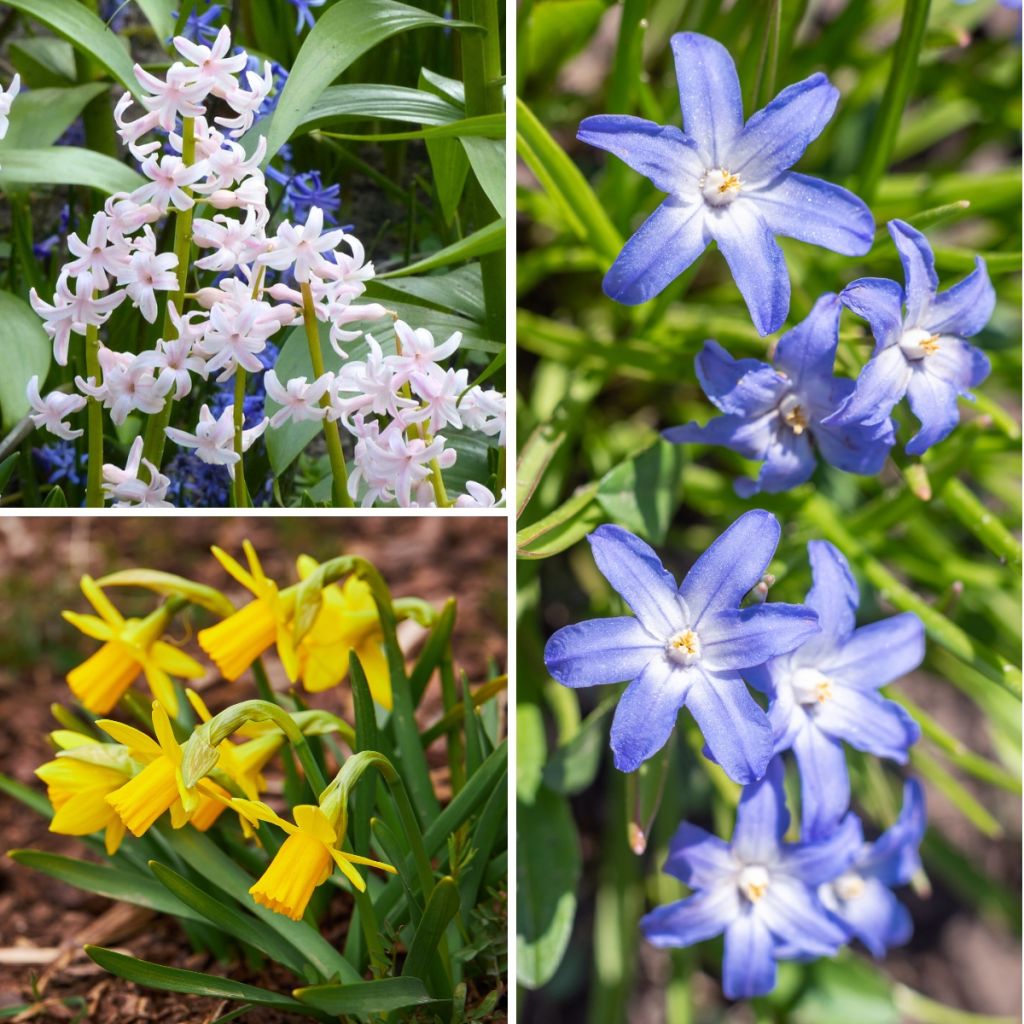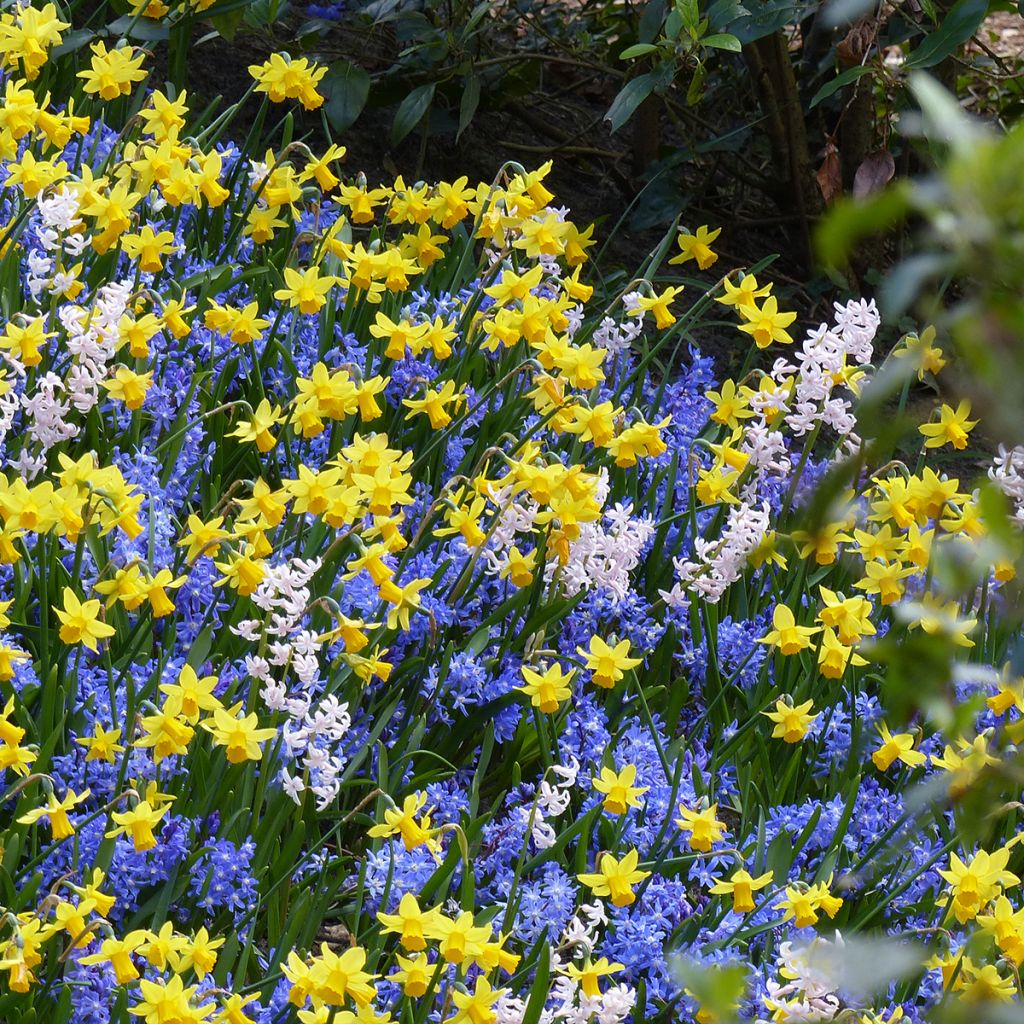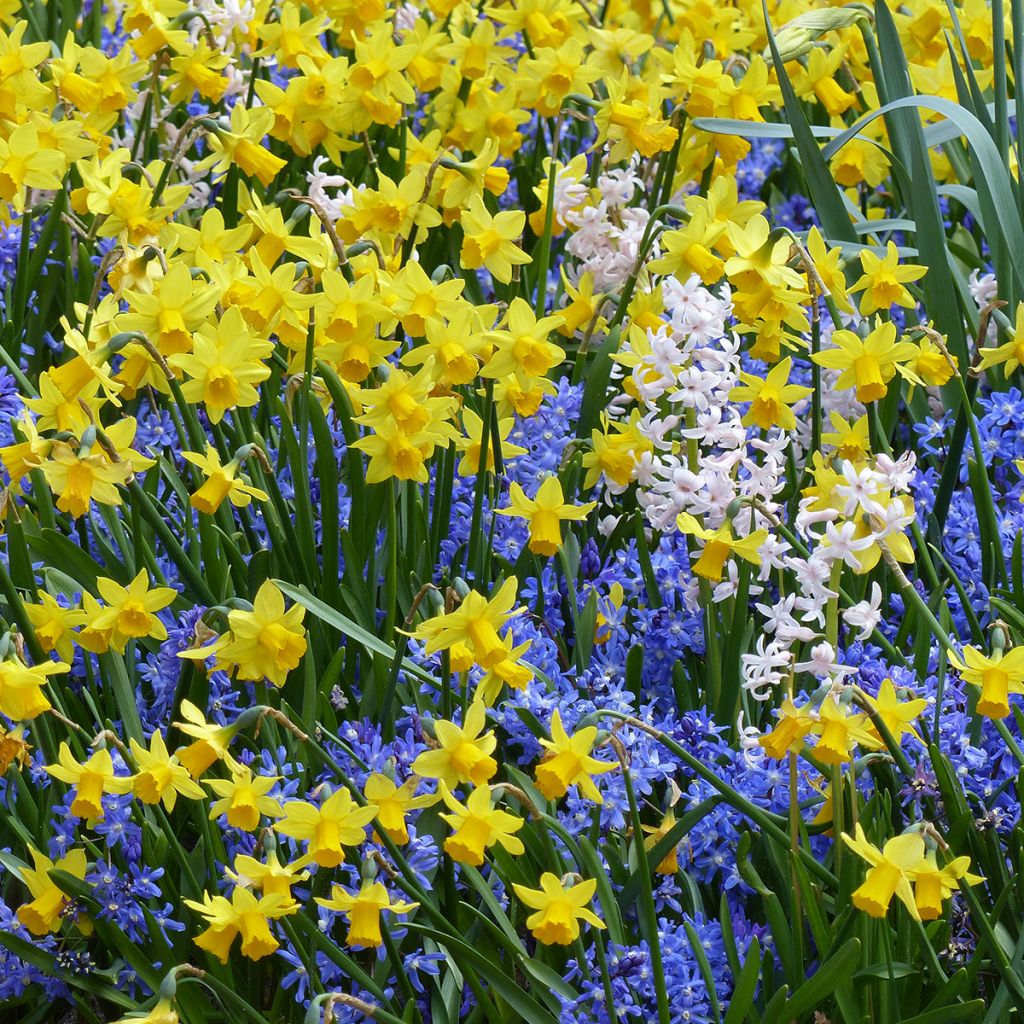

Inspiration collection of small spring bulbs with contrasting flowering


Inspiration collection of small spring bulbs with contrasting flowering


Inspiration collection of small spring bulbs with contrasting flowering
Inspiration collection of small spring bulbs with contrasting flowering
Narcissus, Chionodoxa, Hyacinthus
This plant carries a 6 months recovery warranty
More information
We guarantee the quality of our plants for a full growing cycle, and will replace at our expense any plant that fails to recover under normal climatic and planting conditions.
From €5.90 for pickup delivery and €6.90 for home delivery
Express home delivery from €8.90.
Does this plant fit my garden?
Set up your Plantfit profile →
Collection items (38 plants)
Description
This Inspiration collection for small spring bulbs with contrasting flowering consists of 38 bulbs in total. The lemon-yellow scented trumpets of the daffodil lead the way, closely followed by the blue flowers with white touches of the Chionodoxa and the multiflorous hyacinth, both highly scented. Flowering takes place from late February to late April or early May, depending on the climate. Yellow, blue, and pink to welcome spring with a bang!
This Collection consists of:
x 10 Narcissus cyclamineus Tête à Tête: one of the earliest, flowering between late February and March depending on the region. Each 25 cm tall stem carries 2 to 3 small lemon-yellow, scented flowers. It prefers soils that are not too chalky and not too dry in summer.
x 25 Chionodoxa sardensis (Scilla sardensis): called glory of the snow, this pretty bulb forms large carpets over time of delicate and refined blue star-shaped flowers with white hearts, at 15 cm above the ground. This plant multiplies and spreads spontaneously in the garden.
x 3 Hyacinthus Multiflora Rose: this plant produces several spikes of flowers instead of the single one usually observed in hyacinths. The star-shaped flowers of this variety are quite bright pink, highly scented, and have excellent longevity. A lovely tuft of light spikes, with a very natural appearance, in March-April.
The plants are labelled separately.
Plant the bulbs in autumn, in large groups, along the edge of a lawn, in a rockery, at the front of your flower beds, or even in large planters to be placed near the house. Mix the varieties for a multicoloured and contrasting effect or separate them to create spots of color. These plants are perfectly hardy and easy to grow in soils that are not too wet, not too chalky, and not too dry in summer. A good horticultural compost, mixed with garden soil, will be perfect. A sunny location will guarantee a beautiful flowering. The bulbs should be planted deep enough so that they are covered with a layer of soil equal to twice their height.
Report an error about the product description
Inspiration collection of small spring bulbs with contrasting flowering in pictures


Plant habit
Flowering
Foliage
Botanical data
Narcissus, Chionodoxa, Hyacinthus
Cultivar or hybrid
Planting and care
Plant your bulbs as soon as possible in well-drained soil that does not retain excess water. Loosen the soil deeply, mix in some compost and non-chalky gravel if your soil is very clayey and heavy. The bulbs should be covered with soil to a depth twice their height. Space the bulbs apart, making sure they do not touch each other. Choose a sunny exposure (in spring), or even partially shaded in summer. In hot climates, prefer partial shade or plant at the base of deciduous bushes and trees.
Planting period
Intended location
Care
This item has not been reviewed yet - be the first to leave a review about it.
Haven't found what you were looking for?
Hardiness is the lowest winter temperature a plant can endure without suffering serious damage or even dying. However, hardiness is affected by location (a sheltered area, such as a patio), protection (winter cover) and soil type (hardiness is improved by well-drained soil).

Photo Sharing Terms & Conditions
In order to encourage gardeners to interact and share their experiences, Promesse de fleurs offers various media enabling content to be uploaded onto its Site - in particular via the ‘Photo sharing’ module.
The User agrees to refrain from:
- Posting any content that is illegal, prejudicial, insulting, racist, inciteful to hatred, revisionist, contrary to public decency, that infringes on privacy or on the privacy rights of third parties, in particular the publicity rights of persons and goods, intellectual property rights, or the right to privacy.
- Submitting content on behalf of a third party;
- Impersonate the identity of a third party and/or publish any personal information about a third party;
In general, the User undertakes to refrain from any unethical behaviour.
All Content (in particular text, comments, files, images, photos, videos, creative works, etc.), which may be subject to property or intellectual property rights, image or other private rights, shall remain the property of the User, subject to the limited rights granted by the terms of the licence granted by Promesse de fleurs as stated below. Users are at liberty to publish or not to publish such Content on the Site, notably via the ‘Photo Sharing’ facility, and accept that this Content shall be made public and freely accessible, notably on the Internet.
Users further acknowledge, undertake to have ,and guarantee that they hold all necessary rights and permissions to publish such material on the Site, in particular with regard to the legislation in force pertaining to any privacy, property, intellectual property, image, or contractual rights, or rights of any other nature. By publishing such Content on the Site, Users acknowledge accepting full liability as publishers of the Content within the meaning of the law, and grant Promesse de fleurs, free of charge, an inclusive, worldwide licence for the said Content for the entire duration of its publication, including all reproduction, representation, up/downloading, displaying, performing, transmission, and storage rights.
Users also grant permission for their name to be linked to the Content and accept that this link may not always be made available.
By engaging in posting material, Users consent to their Content becoming automatically accessible on the Internet, in particular on other sites and/or blogs and/or web pages of the Promesse de fleurs site, including in particular social pages and the Promesse de fleurs catalogue.
Users may secure the removal of entrusted content free of charge by issuing a simple request via our contact form.
The flowering period indicated on our website applies to countries and regions located in USDA zone 8 (France, the United Kingdom, Ireland, the Netherlands, etc.)
It will vary according to where you live:
- In zones 9 to 10 (Italy, Spain, Greece, etc.), flowering will occur about 2 to 4 weeks earlier.
- In zones 6 to 7 (Germany, Poland, Slovenia, and lower mountainous regions), flowering will be delayed by 2 to 3 weeks.
- In zone 5 (Central Europe, Scandinavia), blooming will be delayed by 3 to 5 weeks.
In temperate climates, pruning of spring-flowering shrubs (forsythia, spireas, etc.) should be done just after flowering.
Pruning of summer-flowering shrubs (Indian Lilac, Perovskia, etc.) can be done in winter or spring.
In cold regions as well as with frost-sensitive plants, avoid pruning too early when severe frosts may still occur.
The planting period indicated on our website applies to countries and regions located in USDA zone 8 (France, United Kingdom, Ireland, Netherlands).
It will vary according to where you live:
- In Mediterranean zones (Marseille, Madrid, Milan, etc.), autumn and winter are the best planting periods.
- In continental zones (Strasbourg, Munich, Vienna, etc.), delay planting by 2 to 3 weeks in spring and bring it forward by 2 to 4 weeks in autumn.
- In mountainous regions (the Alps, Pyrenees, Carpathians, etc.), it is best to plant in late spring (May-June) or late summer (August-September).
The harvesting period indicated on our website applies to countries and regions in USDA zone 8 (France, England, Ireland, the Netherlands).
In colder areas (Scandinavia, Poland, Austria...) fruit and vegetable harvests are likely to be delayed by 3-4 weeks.
In warmer areas (Italy, Spain, Greece, etc.), harvesting will probably take place earlier, depending on weather conditions.
The sowing periods indicated on our website apply to countries and regions within USDA Zone 8 (France, UK, Ireland, Netherlands).
In colder areas (Scandinavia, Poland, Austria...), delay any outdoor sowing by 3-4 weeks, or sow under glass.
In warmer climes (Italy, Spain, Greece, etc.), bring outdoor sowing forward by a few weeks.






































